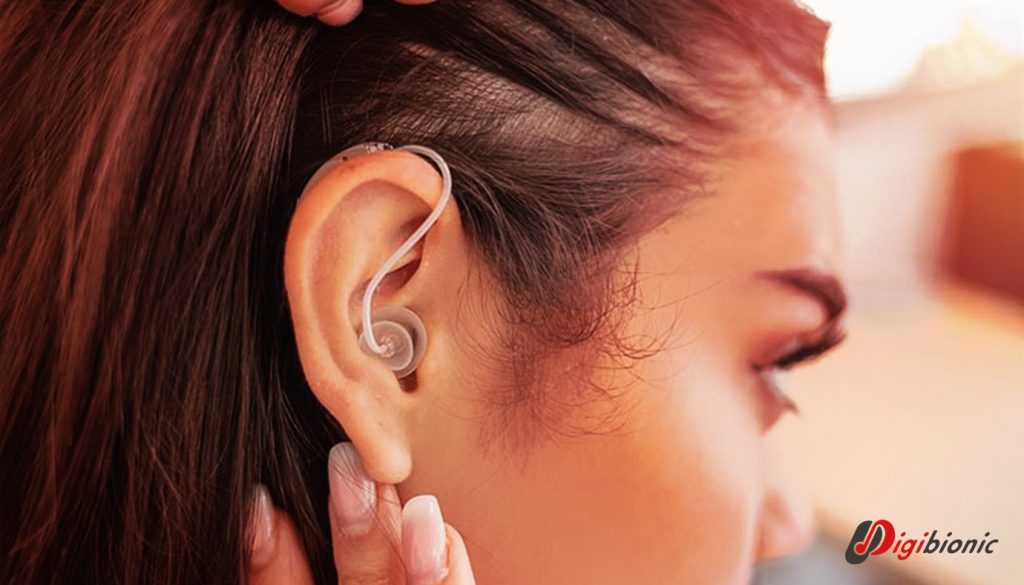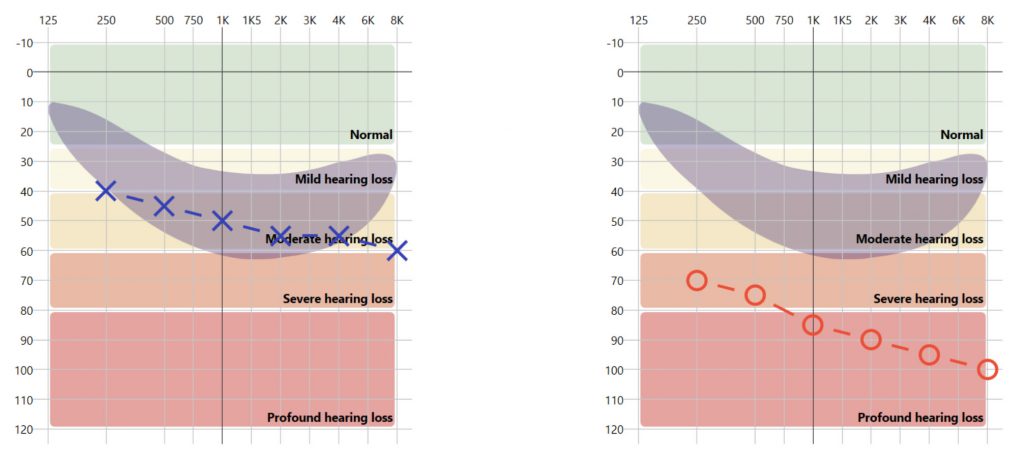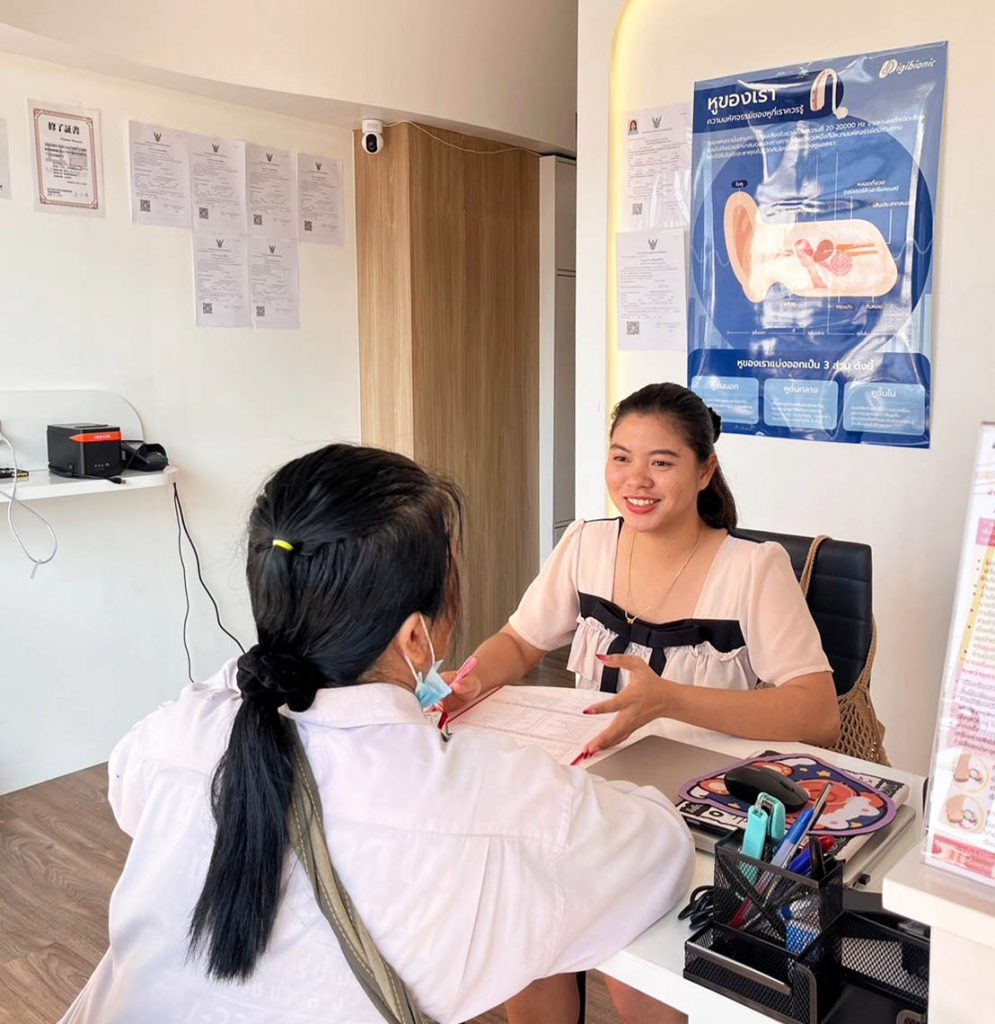
Should I Wear a Hearing Aid in One Ear or Both?
And Is It Possible to Wear Just One? This is a common question for many people experiencing hearing loss.
The answer is: Yes, you can — however, wearing only one hearing aid comes with conditions and is not suitable for everyone.
Let’s explore when wearing just one hearing aid might be appropriate.
First, there’s one specific group of people who should wear only one hearing aid — those with unilateral hearing loss!
If only one ear has hearing loss or is completely unable to hear while the other ear hears normally, a hearing aid will only “benefit” the ear with hearing loss. In this case, wearing just one hearing aid is perfectly fine. In recent years, society has become increasingly aware of the challenges faced by individuals with single-sided hearing loss, and wearing a hearing aid in one ear has become more common in Thailand.
To further improve hearing ability, some people with unilateral hearing loss consider using bilateral sound transmission hearing aids (CROS systems).
The Signia CROS hearing solution is the ideal choice for individuals with single-sided deafness that cannot be treated. Worn in both ears, it enhances sound perception and overall hearing.
For those with hearing loss in one ear, CROS Silk X offers the most discreet in-the-ear solution in the world, while CROS Pure 312 X, a RIC-style hearing aid, provides all the benefits of the Signia Xperience platform with a sleek, modern design — ensuring clear sound and enjoyable hearing in any situation.
In Thailand, the government also provides financial support. Social Security beneficiaries can claim up to 12,500 THB per ear for bilateral hearing aids. This support not only helps prevent further hearing deterioration but also significantly reduces the financial burden for users.
For more details about Social Security subsidies and how to apply, please visit:
What about people with hearing loss in both ears?
Can they wear a hearing aid in just one ear?
In general, there are several conditions for people who have bilateral hearing loss:
Type 1: Both ears have hearing loss, but one ear has mild loss (the “better ear”), while the other has more severe loss (the “weaker ear”).

( Audiogram )
According to experiences from hospitals and hearing centers, it is generally recommended to wear hearing aids in both ears. If you prefer to wear only one, it’s best to use it in the ear with better hearing, as the stronger ear’s cells and natural auditory functions will help your hearing aid perform more effectively. Wearing your hearing aid for about 8 hours a day also helps stimulate the auditory nerves, slow down hearing deterioration, and protect your better ear from worsening. However, be aware that the hearing gap between your good and weaker ear may widen over time, leading to an imbalance in your overall hearing ability.
What happens if you wear the hearing aid in the weaker ear instead of the better one?
It’s not impossible, but generally not recommended — as it often results in a poorer hearing experience than wearing the hearing aid in the better ear. From real-life cases, many people say, “I hear less from this side (the bad ear). If it really works, shouldn’t it make this ear hear better? Why do you suggest putting it in the ear that already hears better?”
In reality, audiologists wish it were that simple. Hearing ability and hearing aid performance are directly connected. While wearing a hearing aid in the weaker ear does help you hear more than without it, wearing it in the stronger ear typically produces a better overall hearing experience.
Type 2: Both ears have similar levels of hearing loss
When both ears have nearly equal hearing loss, if you plan to wear only one hearing aid, it’s recommended that you visit our hearing center to test in real-life conditions and determine which ear is more suitable. Usually, we suggest wearing it in the ear with slightly better hearing.
However, wearing only one hearing aid carries certain risks — the untreated ear may deteriorate faster, you may struggle to identify the direction of sounds or dangers such as traffic, and people may need to stand on your aided side to communicate effectively. Therefore, for individuals with hearing loss in both ears, we strongly advise against using only one hearing aid.
It’s better to allocate your budget for two hearing aids instead of one.
This approach not only prevents faster hearing deterioration but also ensures both ears hear more effectively. Mathematically, 1+1=2, but wearing hearing aids in both ears offers more than double the benefits — including slowing hearing decline, improving communication, and accurately identifying the direction of sounds or hazards. All of these highlight the importance of binaural hearing in daily life.
That’s why some of our hearing aid products, such as the Goodhearing Series and Gohearing Series, are sold in pairs.
For elderly users, we also offer single high-power hearing aids for improved hearing clarity.
In summary, hearing aids effectively address hearing loss, and whether worn in one or both ears, they significantly impact hearing performance. Generally, we recommend wearing hearing aids in both ears for balanced hearing. If you must wear only one, choose the ear with better hearing.
| Wearing One Hearing Aid | Wearing Two Hearing Aids | |
|---|---|---|
| For single-sided hearing loss | Excellent | In some cases, use bilateral sound transmission type |
| Worn in the better ear | Fair | Excellent |
| Worn in the poorer ear | Poor | Excellent |
| Worn in both ears | Fair | Excellent |
| (When hearing loss in both ears is not significantly different) |
(Recommended Number of Hearing Aids for Use)
However, the actual situation for each case is much more complex than theory.
A more accurate approach is to find the most suitable device for the hearing-impaired person through an on-site hearing test, evaluation of living and working environments, user behavior, and other assessment procedures.
All Digibionic hearing aid stores in Thailand are equipped with hearing test instruments and equipment. You can make an appointment at any store for a free hearing test and evaluation. Audiologists can provide the most suitable recommendations for you. Our after-sales service offers peace of mind — free maintenance every 2 months and sound adjustments anytime you need.Book a free hearing test now to improve your hearing!

เราใช้คุกกี้เพื่อพัฒนาประสิทธิภาพ และประสบการณ์ที่ดีในการใช้เว็บไซต์ของคุณ คุณสามารถศึกษารายละเอียดได้ที่ นโยบายความเป็นส่วนตัว และสามารถจัดการความเป็นส่วนตัวเองได้ของคุณได้เองโดยคลิกที่ ตั้งค่า